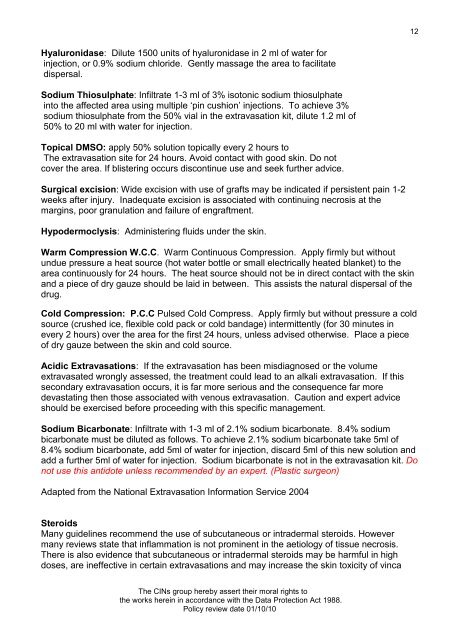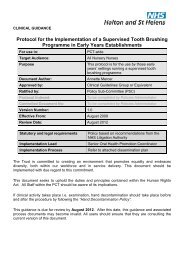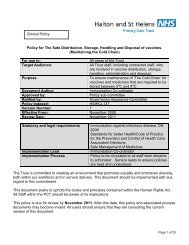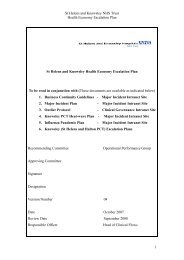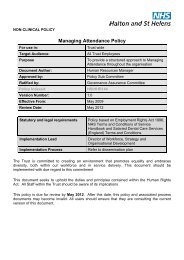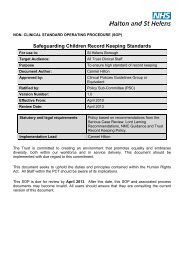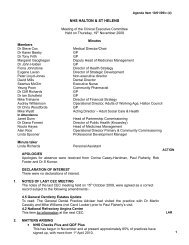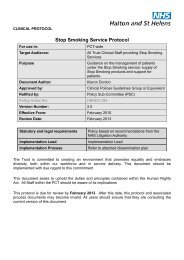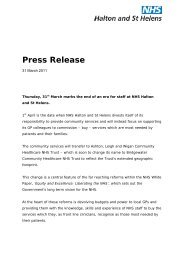Collaborative Intravenous Nursing Service (CINS) Guidelines
Collaborative Intravenous Nursing Service (CINS) Guidelines
Collaborative Intravenous Nursing Service (CINS) Guidelines
- No tags were found...
You also want an ePaper? Increase the reach of your titles
YUMPU automatically turns print PDFs into web optimized ePapers that Google loves.
12Hyaluronidase: Dilute 1500 units of hyaluronidase in 2 ml of water forinjection, or 0.9% sodium chloride. Gently massage the area to facilitatedispersal.Sodium Thiosulphate: Infiltrate 1-3 ml of 3% isotonic sodium thiosulphateinto the affected area using multiple ‘pin cushion’ injections. To achieve 3%sodium thiosulphate from the 50% vial in the extravasation kit, dilute 1.2 ml of50% to 20 ml with water for injection.Topical DMSO: apply 50% solution topically every 2 hours toThe extravasation site for 24 hours. Avoid contact with good skin. Do notcover the area. If blistering occurs discontinue use and seek further advice.Surgical excision: Wide excision with use of grafts may be indicated if persistent pain 1-2weeks after injury. Inadequate excision is associated with continuing necrosis at themargins, poor granulation and failure of engraftment.Hypodermoclysis: Administering fluids under the skin.Warm Compression W.C.C. Warm Continuous Compression. Apply firmly but withoutundue pressure a heat source (hot water bottle or small electrically heated blanket) to thearea continuously for 24 hours. The heat source should not be in direct contact with the skinand a piece of dry gauze should be laid in between. This assists the natural dispersal of thedrug.Cold Compression: P.C.C Pulsed Cold Compress. Apply firmly but without pressure a coldsource (crushed ice, flexible cold pack or cold bandage) intermittently (for 30 minutes inevery 2 hours) over the area for the first 24 hours, unless advised otherwise. Place a pieceof dry gauze between the skin and cold source.Acidic Extravasations: If the extravasation has been misdiagnosed or the volumeextravasated wrongly assessed, the treatment could lead to an alkali extravasation. If thissecondary extravasation occurs, it is far more serious and the consequence far moredevastating then those associated with venous extravasation. Caution and expert adviceshould be exercised before proceeding with this specific management.Sodium Bicarbonate: Infiltrate with 1-3 ml of 2.1% sodium bicarbonate. 8.4% sodiumbicarbonate must be diluted as follows. To achieve 2.1% sodium bicarbonate take 5ml of8.4% sodium bicarbonate, add 5ml of water for injection, discard 5ml of this new solution andadd a further 5ml of water for injection. Sodium bicarbonate is not in the extravasation kit. Donot use this antidote unless recommended by an expert. (Plastic surgeon)Adapted from the National Extravasation Information <strong>Service</strong> 2004SteroidsMany guidelines recommend the use of subcutaneous or intradermal steroids. Howevermany reviews state that inflammation is not prominent in the aetiology of tissue necrosis.There is also evidence that subcutaneous or intradermal steroids may be harmful in highdoses, are ineffective in certain extravasations and may increase the skin toxicity of vincaThe CINs group hereby assert their moral rights tothe works herein in accordance with the Data Protection Act 1988.Policy review date 01/10/10


